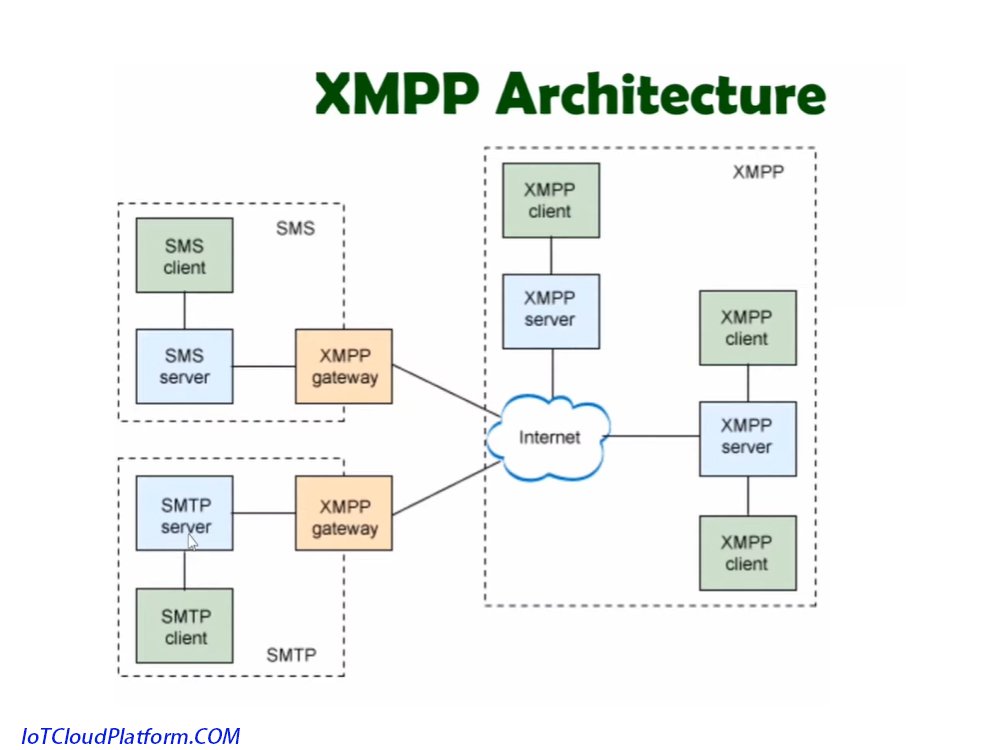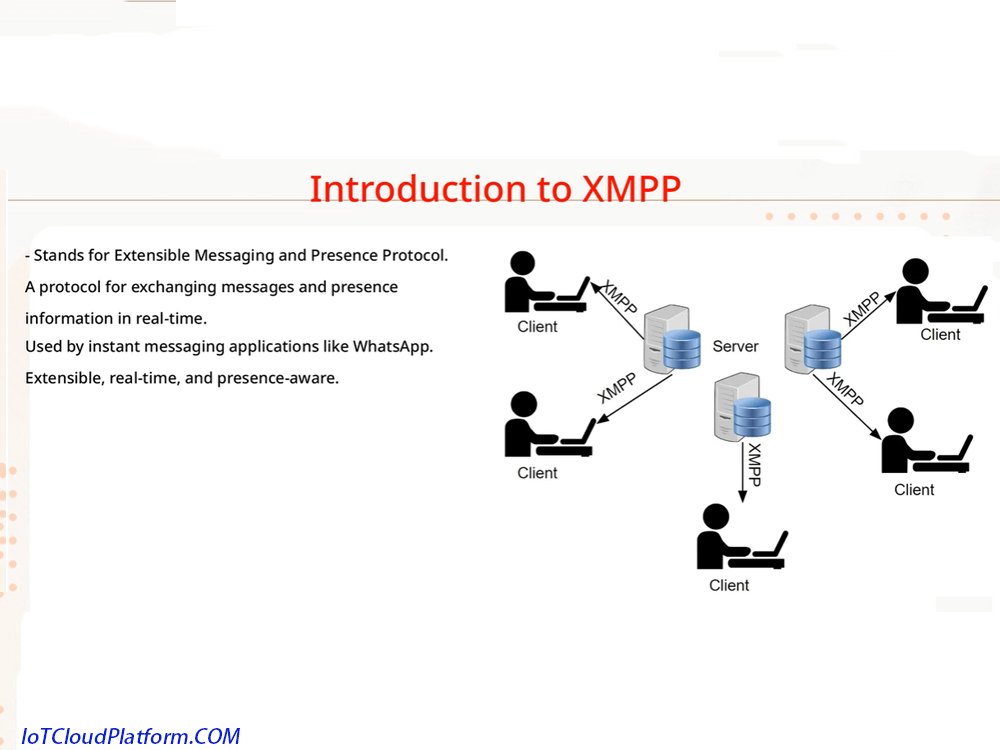
XMPP Protocol in IoT
The XMPP protocol in IoT is a complex and powerful communication protocol. Its application in the field of IoT provides a solid foundation for instant messaging, state sharing and multiple interactions between devices.
The IoT Cloud Platform will now provide you with a detailed introduction to the technical knowledge related to the XMPP protocol in the IoT.
XMPP protocol overview
XMPP (Extensible Messaging and Presence Protocol), which is an extensible messaging and presence protocol, is an instant messaging protocol based on XML (Extensible Markup Language). It allows Internet users to send instant messages to anyone else, regardless of their operating system and browser. The predecessor of XMPP is Jabber, a network instant messaging protocol generated by an open source organization, which was later standardized by the IETF (Internet Engineering Task Force) international standards organization.

Introduction to XMPP Protocol
XMPP protocol stack and network architecture
The XMPP protocol stack is an application layer protocol based on TCP/IP, which defines three main roles: client, server and gateway. The client is the instant messaging application used by the user, the server is responsible for storing client information, managing connections, and routing information, while the gateway is responsible for interconnection with other heterogeneous instant messaging systems, such as SMS (text messages), MSN, ICQ, etc.
In terms of network architecture, XMPP adopts a distributed network structure, similar to the email system. Anyone can run their own XMPP server, which enables individuals and organizations to control their communication experience. This decentralization not only improves the flexibility and scalability of the system, but also enhances the system’s anti-attack capabilities.
How XMPP works
XMPP works by passing small structured XML data blocks between endpoints (clients) through an intermediate server. When a user uses XMPP to send a message to a friend, the message is first transmitted to the server as part of an XML document, rather than directly to the friend’s device. The server uses the client’s unique name (similar to an email address) to identify and route messages.
During the communication process, XMPP establishes a persistent TCP connection, so there is no need to re-establish the connection every time a new message is sent. This improves the efficiency of communication and reduces latency. In addition, XMPP also supports asynchronous messaging, allowing users to send multiple messages continuously without waiting for a response.
XMPP protocol features
1. Openness:
The XMPP protocol is open and easy to understand, and is developed by the JSF open source community organization. It does not belong to any organization or individual, but to the entire community, which fundamentally guarantees its openness.
2. Extensibility:
Since XMPP is an XML-based protocol, it inherits the flexible development of the XML environment. Anyone can build custom functions on top of the core protocol to meet specific needs. This extensibility enables XMPP to be applied to a variety of scenarios, such as instant messaging, status sharing, multi-party chat, voice and video calls, etc.
3. Distributed network:
The distributed network architecture of XMPP is similar to an email system, without a centralized server. Anyone can run their own XMPP server, which makes the system more flexible and extensible.
4. Security:
XMPP uses the TLS (Transport Layer Security) protocol as the encryption method for the communication channel in both Client-to-Server communication and Server-to-Server communication, ensuring the security of communication. In addition, the XMPP developer community is actively working on end-to-end encryption to further improve security standards.
5. Flexibility:
In addition to instant messaging applications, XMPP can also be applied to network management, content syndication, collaboration tools, file sharing, games, remote system monitoring and many other fields. This flexibility makes XMPP a highly promising communication protocol in the Internet of Things.
Application of XMPP in the Internet of Things
In the Internet of Things, the application of the XMPP protocol is mainly reflected in the following aspects:
1. Instant messaging between devices:
XMPP allows IoT devices to send and receive instant messages, which is essential for IoT applications that require real-time interaction. For example, various devices in a smart home system can communicate with each other through the XMPP protocol to achieve intelligent control and linkage.
2. State sharing and monitoring:
The “presence” function in the XMPP protocol allows devices to share their status information, such as online/offline status, busy/idle status, etc. This is very useful for device monitoring and management in the Internet of Things. For example, an IoT platform can obtain the status information of each device in real time through the XMPP protocol, and make corresponding management and scheduling decisions based on this information.
3. Multi-party chat and collaboration:
XMPP supports multi-party chat and collaboration functions, which enables IoT devices to communicate and collaborate with other devices or users in groups. This is very useful for IoT applications that require multiple devices or users to complete tasks together. For example, in industrial automation scenarios, multiple robots or sensors can collaborate through the XMPP protocol to achieve a more efficient production process.
4. Voice and video calls:
Through Jingle, an extension protocol of XMPP, IoT devices can also support voice and video call functions. This is very useful for IoT applications that require remote interaction and monitoring. For example, in telemedicine scenarios, doctors can make video calls with patients through the XMPP protocol for remote diagnosis and treatment.
Advantages and challenges of the XMPP protocol
Advantages:
- Standardization: The XMPP protocol has been standardized by the IETF international standards organization, which ensures its interoperability between different devices and platforms.
- Openness: The openness of the XMPP protocol allows anyone to participate in its development and improvement, which promotes the rapid development and widespread application of the technology.
- Scalability: The XML-based protocol structure makes XMPP extremely scalable and can meet the needs of different IoT applications.
- Security: The XMPP protocol has built-in security mechanisms such as TLS encryption and SASL authentication to ensure the security and reliability of communication.
Challenges:
- Resource consumption: Although the XMPP protocol is very suitable for IoT systems in terms of communication business processes, its XML-based data format may increase resource consumption and transmission delays. This is a challenge for resource-constrained IoT devices.
- Development complexity: Due to the high scalability and flexibility of the XMPP protocol, developers need to spend more time and energy to familiarize themselves with and master its development techniques and tools. This increases the complexity and cost of development.
- Heterogeneous system interconnection: Although the XMPP protocol supports interconnection with heterogeneous instant messaging systems, compatibility and interoperability issues may be encountered in actual applications. This requires developers to perform additional adaptation and debugging work.
Conclusion and Outlook
As an important communication protocol in the Internet of Things, the XMPP protocol has many advantages such as openness, scalability, distributed network architecture and security.
It plays an important role in instant messaging, status sharing and monitoring, multi-party chat and collaboration, and voice and video calls between devices. However, the XMPP protocol also faces challenges such as resource consumption, development complexity and heterogeneous system interconnection.
In the future, with the continuous development of Internet of Things technology and the continuous expansion of application fields, the XMPP protocol is expected to be more widely used and improved.
For example, resource consumption can be reduced and transmission efficiency can be improved by optimizing data formats and transmission mechanisms; more extended protocols and functions can be developed to meet the needs of different Internet of Things applications; and interoperability and compatibility with other communication protocols can be strengthened to achieve more efficient and convenient Internet of Things communication.
In summary, the XMPP protocol has broad application prospects and development potential in the Internet of Things. Through continuous technological innovation and improvement, it will make greater contributions to the development of the Internet of Things field.
About IoT Cloud Platform
IOT Cloud Platform (blog.iotcloudplatform.com) focuses on IoT design, IoT programming, security IoT, industrial IoT, military IoT, best IoT projects, IoT creativity, IoT companies, Chinese IoT companies, American IoT companies, top IoT companies, IoT modules, embedded development, IoT circuit boards, IoT solutions, Raspberry Pi development and design, Arduino programming, programming languages, RFID, lora devices, IoT systems, sensors, temperature and humidity sensors, liquid level sensors, sensor devices, artificial intelligence, blockchain, robotic arms, smart homes, smart cities, smart agricultural factories, edge computing, big data, cloud computing, brain-computer interfaces, machine learning, robots, VR/AR, AI simulation technology, motion control, new energy, photovoltaic solar energy, lithium batteries, silicon brain SBB, unmanned aerospace navigation, unmanned driving, AGI, chips, semiconductors, smart hardware and other scientific and technological knowledge.
FAQs
Here are some common questions and brief answers about the XMPP protocol in the Internet of Things:
Answer: XMPP (Extensible Messageing and Presence Protocol) is an extensible messaging and presence protocol, and is one of the four mainstream IM (instant messaging) protocols. It is a protocol based on Extensible Markup Language (XML) for instant messaging (IM) and online site detection. XMPP allows Internet users to send instant messages to anyone else on the Internet, even if their operating systems and browsers are different.
Answer: The characteristics of the XMPP protocol include:
Openness: Developed by the JSF open source community organization, it does not belong to any organization or individual, but to the entire community, which ensures its openness.
Extensibility: Instant messages and presence information are both structured information based on XML. This information is exchanged between communication entities in the form of XML stanzas, which has good scalability.
Distributed architecture: Based on the C/S architecture, but with a very wide range of applications, it is not combined with any specific network architecture.
Flexibility: In addition to being used in instant messaging applications, it can also be used in network management, content feeds, collaborative tools, file sharing, games, remote system monitoring, etc.
Security: The TLS (Transport Layer Security) protocol is used as the encryption method for the communication channel in both Client-to-Server communication and Server-to-Server communication to ensure the security of communication.
Answer: The application of the XMPP protocol in the Internet of Things is mainly in instant messaging communication, such as status updates and alarm notifications between devices. Through the XMPP protocol, IoT devices can achieve real-time message communication and improve the response speed and reliability of the system.
Answer: Compared with IoT communication protocols such as MQTT and CoAP, the main difference between the XMPP protocol and the MQTT and CoAP is its XML-based structured information and instant messaging characteristics. MQTT and CoAP focus more on lightweight and low-power communications, and are suitable for scenarios such as sensor networks and smart homes. XMPP, on the other hand, focuses more on the immediacy and scalability of messages, and is suitable for IoT scenarios that require real-time communication and complex message processing.
Answer: To use the XMPP protocol for device communication in the IoT, the device needs to support the XMPP protocol and configure the corresponding XMPP client or server. Devices can send and receive messages through the XMPP protocol to achieve real-time communication and status updates. At the same time, the stability and security of the network environment need to be ensured to ensure the reliability and security of communication.



